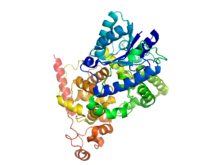
Back الكريبتوكرومات Arabic CRY1 BS Criptocrom Catalan Cryptochrome German Criptocromo Spanish کریپتوکروم Persian Kryptokromi Finnish Cryptochrome French Criptocromo Galician קריפטוכרום HE
| Cryptochrome-1 | |||||||
|---|---|---|---|---|---|---|---|
 Crystallographic structure of Cryptochrome-1 | |||||||
| Identifiers | |||||||
| Symbol | CRY1 | ||||||
| NCBI gene | 1407 | ||||||
| HGNC | 2384 | ||||||
| OMIM | 601933 | ||||||
| PDB | 5T5X | ||||||
| RefSeq | NP_004066 | ||||||
| UniProt | Q16526 | ||||||
| Other data | |||||||
| Locus | Chr. 12 q23.3 | ||||||
| |||||||
| Cryptochrome-2 | |||||||
|---|---|---|---|---|---|---|---|
| Identifiers | |||||||
| Symbol | CRY2 | ||||||
| NCBI gene | 1408 | ||||||
| HGNC | 2385 | ||||||
| OMIM | 603732 | ||||||
| PDB | 4MLP | ||||||
| RefSeq | NP_066940 | ||||||
| UniProt | Q49AN0 | ||||||
| Other data | |||||||
| Locus | Chr. 11 p11.2 | ||||||
| |||||||
Cryptochromes (from the Greek κρυπτός χρώμα, "hidden colour") are a class of flavoproteins found in plants and animals that are sensitive to blue light. They are involved in the circadian rhythms and the sensing of magnetic fields in a number of species. The name cryptochrome was proposed as a portmanteau combining the chromatic nature of the photoreceptor, and the cryptogamic organisms on which many blue-light studies were carried out.[1][2]
The genes CRY1 and CRY2 encode the proteins CRY1 and CRY2, respectively.[3] Cryptochromes are classified into plant Cry and animal Cry. Animal Cry can be further categorized into insect type (Type I) and mammal-like (Type II). CRY1 is a circadian photoreceptor whereas CRY2 is a clock repressor which represses Clock/Cycle (Bmal1) complex in insects and vertebrates.[4] In plants, blue-light photoreception can be used to cue developmental signals.[5] Besides chlorophylls, cryptochromes are the only proteins known to form photoinduced radical-pairs in vivo.[6] These appear to enable some animals to detect magnetic fields.
Cryptochromes have been the focus of several current efforts in optogenetics. Employing transfection, initial studies on yeast have capitalized on the potential of CRY2 heterodimerization to control cellular processes, including gene expression, by light.
- ^ Cite error: The named reference
Gressel_1979was invoked but never defined (see the help page). - ^ Cite error: The named reference
Yang_2017was invoked but never defined (see the help page). - ^ Cite error: The named reference
van_der_Spek_1996was invoked but never defined (see the help page). - ^ Cite error: The named reference
Ozturk_2017was invoked but never defined (see the help page). - ^ Cite error: The named reference
Brautigam_2004was invoked but never defined (see the help page). - ^ Cite error: The named reference
Hore_2016was invoked but never defined (see the help page).
© MMXXIII Rich X Search. We shall prevail. All rights reserved. Rich X Search